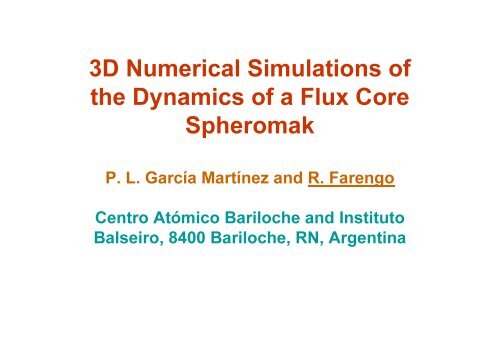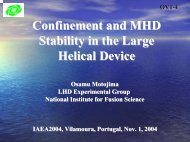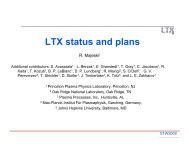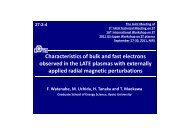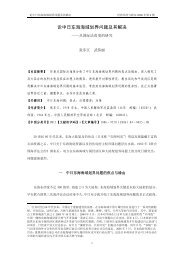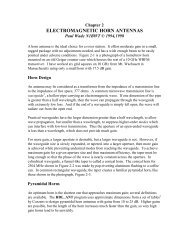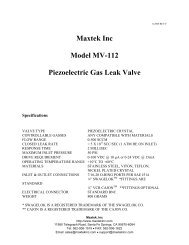3D Numerical Simulations of the Dynamics of a Flux Core ... - SUNIST
3D Numerical Simulations of the Dynamics of a Flux Core ... - SUNIST
3D Numerical Simulations of the Dynamics of a Flux Core ... - SUNIST
You also want an ePaper? Increase the reach of your titles
YUMPU automatically turns print PDFs into web optimized ePapers that Google loves.
<strong>3D</strong> <strong>Numerical</strong> <strong>Simulations</strong> <strong>of</strong><br />
<strong>the</strong> <strong>Dynamics</strong> <strong>of</strong> a <strong>Flux</strong> <strong>Core</strong><br />
Spheromak<br />
P. L. García Martínez and R. Farengo<br />
Centro Atómico Bariloche and Instituto<br />
Balseiro, 8400 Bariloche, RN, Argentina
Motivation<br />
• The PROTO-SPHERA proposes <strong>the</strong> formation and<br />
sustainment <strong>of</strong> an ST-like plasma by dc helicity injection.<br />
• Helicity injection curent drive requires relaxation.<br />
• A certain amount <strong>of</strong> “open” flux through <strong>the</strong> electrodes is<br />
needed for helicity injection, <strong>Flux</strong> <strong>Core</strong> Spheromak (FCS).<br />
• STs have higher elongation than spheromaks (κ>2), <strong>the</strong> tilt<br />
mode could appear.<br />
• The relaxation <strong>of</strong> a FCS with open flux and high elongation<br />
has not been studied.
This work<br />
• Study <strong>the</strong> relaxation <strong>of</strong> a FCS with open flux and high<br />
elongation.<br />
• Solve <strong>the</strong> <strong>3D</strong> resistive MHD equations with <strong>the</strong> VAC code.<br />
• Constant density (zero β), uniform cartesian grid.<br />
• Code tested by recovering known results.
nˆ<br />
Geometry, boundary and initial conditions<br />
Cylindrical flux conserver with<br />
electrodes (Fig.1)<br />
electrode<br />
h<br />
b<br />
Boundary conditions<br />
flux conserver:<br />
B⋅nˆ = J×<br />
nˆ<br />
= 0<br />
Fig. 1<br />
electrodes: B z constant →ψ e : “open” flux<br />
Initial condition: force-free FCS obtained from:<br />
∇ × B = λ(ψ)B<br />
λ( ψ ) = λ[ 1+<br />
α(2ψ−<br />
1) ]<br />
where: λ =J.B/B 2<br />
a
VAC Code<br />
• Solves <strong>3D</strong> resistive MHD equations in cartesian grid:<br />
100×100 × 75.<br />
• Uniform resistivity, τ A =a/v A , τ r =µ 0 /(ηλ 2 ), S=τ r /τ A ~400.<br />
• Tested by recovering known results, i.e. tilting threshold.
No open flux, low elongation<br />
• The only relevant parameter is <strong>the</strong> slope <strong>of</strong> <strong>the</strong> λ pr<strong>of</strong>ile (α).<br />
• Initial condition: regular spheromak (κ=1, ψ e =0).<br />
α=-0.6<br />
α=-0.8<br />
W<br />
K<br />
n=<br />
0<br />
n=<br />
0<br />
-0.8<br />
α=-0.5<br />
-0.7<br />
-0.6<br />
α=0<br />
α=-0.4<br />
t<br />
• The energy in <strong>the</strong> n=1 mode increases with α.<br />
• The relaxation rate increases with α.<br />
• Incomplete relaxation unless I α I is large enough.
No open flux, high elongation<br />
• Kink and tilt modes appear.<br />
• First peak due to kink, second peak due to tilt.<br />
• When κ>1.6 <strong>the</strong> tilt survives.
Kink and Tilt<br />
κ=1.8, α=-0.8,<br />
ψ e =0
Open flux, high elongation<br />
• Kink and tilt modes appear.<br />
• Tilt saturates at lower amplitude.<br />
• Tilt disappears!.
Mode activity<br />
• Initially all <strong>the</strong> modes grow fast.<br />
• During <strong>the</strong> final increase in <strong>the</strong> n=1 mode amplitude <strong>the</strong> o<strong>the</strong>rs<br />
decrease.<br />
• When <strong>the</strong> energy <strong>of</strong> <strong>the</strong> n=1 mode remains constant <strong>the</strong> o<strong>the</strong>rs<br />
grow.<br />
• When <strong>the</strong> n=1 energy decreases all <strong>the</strong> o<strong>the</strong>rs also decrease.
Kink and Tilt<br />
κ=1.8, α=-0.8,<br />
ψ e =10%
Poloidal flux amplification<br />
2.5<br />
2<br />
h = 1.8<br />
α = −0.8<br />
<strong>Flux</strong><br />
1.5<br />
1<br />
toroidal<br />
poloidal<br />
0.5<br />
0 100 200 300 400 500 600<br />
• During <strong>the</strong> kink <strong>the</strong> poloidal flux increases fast and <strong>the</strong> toroidal<br />
flux decreases.<br />
• During <strong>the</strong> tilt, when <strong>the</strong> n=1 mode remains stable, both fluxes<br />
decrease.<br />
• When <strong>the</strong> tilt disappears <strong>the</strong>re are small increases in both<br />
fluxes.<br />
t
Spheromak formation from an unstable<br />
screw pinch<br />
• Same geometry but periodic boundary conditions at<br />
electrodes.<br />
• Initial condition: force-free screw pinch with non uniform λ<br />
pr<strong>of</strong>ile<br />
∇ × B ( r)<br />
= λ(<br />
r)B
Formation sequence<br />
t=30. Kink t=45. Saturation t=69. Reconnection<br />
t=71. Reconnection<br />
t=110. Closed flux surfaces
Evolution <strong>of</strong> different quantities during<br />
formation<br />
Magnetic energy, poloidal flux<br />
and relative helicity<br />
Toroidal and poloidal<br />
currents<br />
λ pr<strong>of</strong>ile


